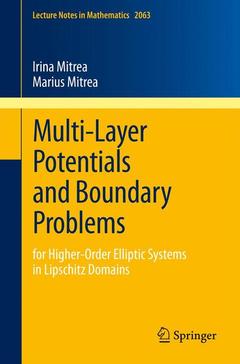Description
Multi-Layer Potentials and Boundary Problems, 2013
for Higher-Order Elliptic Systems in Lipschitz Domains
Lecture Notes in Mathematics Series, Vol. 2063
Authors: Mitrea Irina, Mitrea Marius
Language: English
424 p. · 15.5x23.5 cm · Paperback
Description
/li>Contents
/li>Comment
/li>
Many phenomena in engineering and mathematical physics can be modeled by means of boundary value problems for a certain elliptic differential operator in a given domain. When the differential operator under discussion is of second order a variety of tools are available for dealing with such problems, including boundary integral methods, variational methods, harmonic measure techniques, and methods based on classical harmonic analysis. When the differential operator is of higher-order (as is the case, e.g., with anisotropic plate bending when one deals with a fourth order operator) only a few options could be successfully implemented. In the 1970s Alberto Calderón, one of the founders of the modern theory of Singular Integral Operators, advocated the use of layer potentials for the treatment of higher-order elliptic boundary value problems. The present monograph represents the first systematic treatment based on this approach.
This research monograph lays, for the first time, the mathematical foundation aimed at solving boundary value problems for higher-order elliptic operators in non-smooth domains using the layer potential method and addresses a comprehensive range of topics, dealing with elliptic boundary value problems in non-smooth domains including layer potentials, jump relations, non-tangential maximal function estimates, multi-traces and extensions, boundary value problems with data in Whitney?Lebesque spaces, Whitney?Besov spaces, Whitney?Sobolev- based Lebesgue spaces, Whitney?Triebel?Lizorkin spaces,Whitney?Sobolev-based Hardy spaces, Whitney?BMO and Whitney?VMO spaces.
These books may interest you

Theory of Besov Spaces 137.14 €



